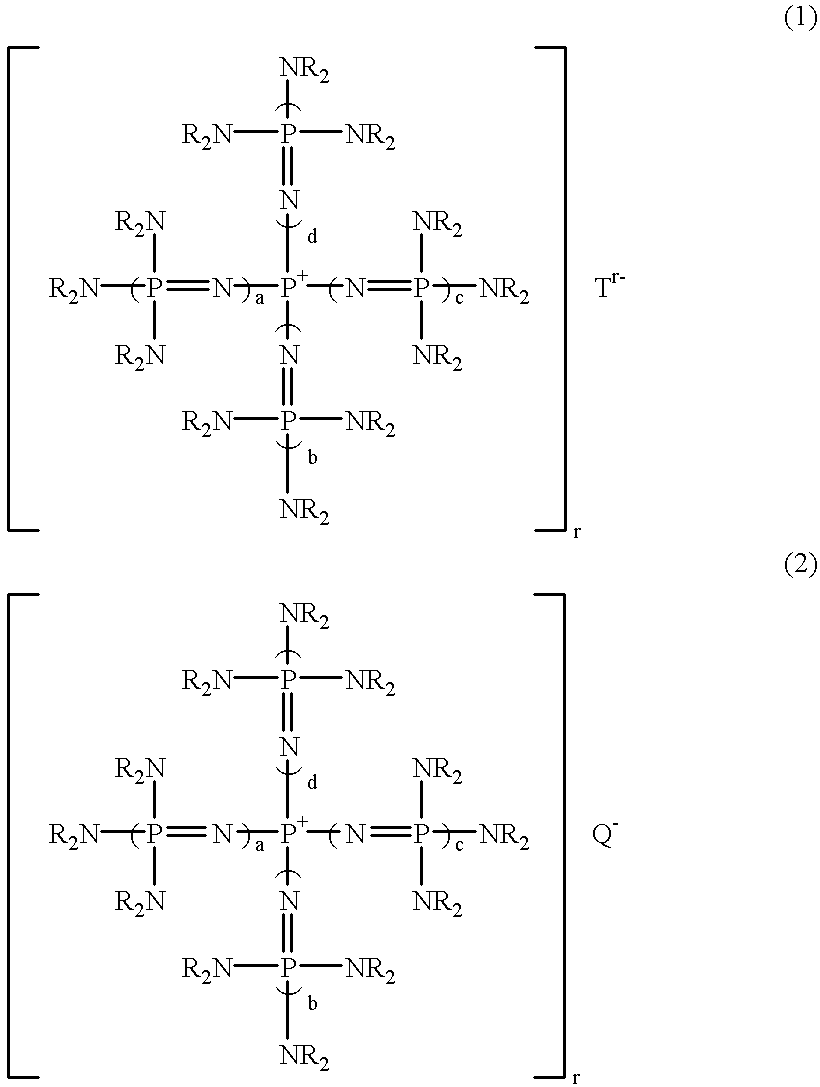Polyoxyalkylene polyols, derivatives thereof, and process for producing the polyoxyalkylene polyols
a technology of polyoxyalkylene polyols and polyoxyalkylene polyols, which is applied in the field of polyoxyalkylene polyols, derivatives thereof, and process for producing the polyoxyalkylene polyols, which can solve the problems of increasing hysteria, increasing the permanent compression set, and reducing the hardness
- Summary
- Abstract
- Description
- Claims
- Application Information
AI Technical Summary
Benefits of technology
Problems solved by technology
Method used
Image
Examples
example 1
Polyoxyalkylene Polyol A
Into a 500 ml four port flasks which were equipped with an agitator, a nitrogen inlet pipe and a thermometer, 0.013 moles of KOH (50 weight % aqueous solution) for every 1 mole of glycerin were added. While nitrogen entered through a capillary tube, vacuum dehydration was conducted for 4 hours under the conditions of 110.degree. C., 10 mmHgabs, (1330 Pa) or lower. Potassium salt of glycerin was produced. (will be referred to as Gly--K).
Next, for every 1 mole of glycerin which was added to produce Gly--K, 0.012 moles of P5NMe2Cl were added. After agitating for 2 hours at 105.degree. C. under nitrogen. atmosphere, vacuum filtration was conducted using a 5C filter paper from Advantech Toyo Corp. After filtration, the compound was placed in the autoclave. After conducting nitrogen substitution, under condition of reaction temperature 70.about.85.degree. C. and a pressure which was at a vacuum condition of 10 mmHgabs (1,330 Pa) and reaching a maximum pressure duri...
example 2
Polyoxyalkylene Polyol B
In a 500 ml four port flask which were equipped with a agitating device, nitrogen inlet pipe, and thermometer, 0.009 moles of KOH (50 weight % aqueous solution) for every 1 mole of dipropylene glycol were added. While nitrogen entered through a capillary tube, vacuum dehydration was conducted for 5 hours under conditions of 103.degree. C., 11 mm Hgabs. (1,463 Pa), and a potassium salt of dipropylene glycol (referred to as DPG-K) was produced. Afterwards, for every 1 mole of propylene glycol which was stocked to prepare DPG-K, 0.008 moles of P5NMe2Cl was added. Under nitrogen atmosphere, after agitating for 2 hours at 100.degree. C., vacuum filtration was conducted with 5C filter paper from Advantech Toyo Corp.
After filtration, the compound was placed in the autoclave. After conducting nitrogen substitution, under conditions of reaction temperature 75.about.78.degree. C., a pressure which goes from vacuum conditions of 20 mmHgabs. (2,660 Pa) to a maximum react...
example 3
Polyoxyalkylene Polyol C
In to a 500 ml four port flask which were equipped with an agitating device, nitrogen inlet pipe, and thermometer, 0.018 moles of KOH (50 weight % aqueous solution) for every 1 mole of glycerin were added. While nitrogen entered through a capillary tube, vacuum dehydration was conducted for 4 hours under condition of 110.degree. C., 8 mm Hgabs. (1,064 Pa) or lower, and a potassium salt of glycerin (referred to as Gly--K) was produced. Afterwards, for every 1 mole of glycerin which was stocked to prepare Gly--K, 0.016 moles of P5NMe2Cl was added. Under nitrogen atmosphere, after agitating for 1 hour at 1 05.degree. C., vacuum filtration was conducted with 5C filter paper from Advantech Toyo Corp.
After filtration, the compound was placed in the autoclave. After conducting nitrogen substitution, the reaction temperature was made to be at 28.degree. C. from a vacuum condition of 10 mmHgabs. (1,330 Pa). 5 weight % of the amount of propylene oxide needed to produce...
PUM
| Property | Measurement | Unit |
|---|---|---|
| Fraction | aaaaa | aaaaa |
| Percent by mass | aaaaa | aaaaa |
| Percent by mass | aaaaa | aaaaa |
Abstract
Description
Claims
Application Information
 Login to View More
Login to View More - R&D
- Intellectual Property
- Life Sciences
- Materials
- Tech Scout
- Unparalleled Data Quality
- Higher Quality Content
- 60% Fewer Hallucinations
Browse by: Latest US Patents, China's latest patents, Technical Efficacy Thesaurus, Application Domain, Technology Topic, Popular Technical Reports.
© 2025 PatSnap. All rights reserved.Legal|Privacy policy|Modern Slavery Act Transparency Statement|Sitemap|About US| Contact US: help@patsnap.com



